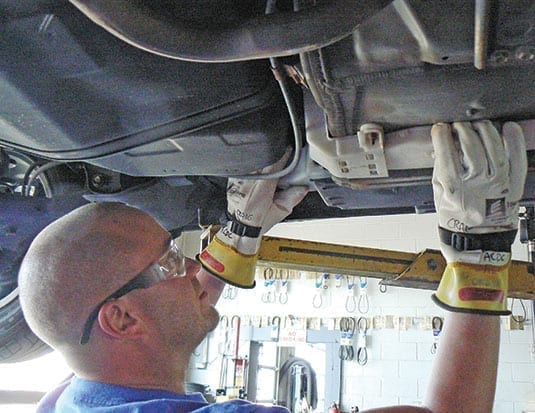Technicians need to be aware of key safety procedures when repairing hybrids.
With the increasing number of hybrid vehicles on the roads today, technicians are seeing them in service bays on a regular basis. A hybrid is generally similar to conventional ICE vehicles, except when it comes down to handling its high voltage parts. Hybrids give off more than 100 volts in direct current (DC), which pierces through the skin and is definitely lethal. A technician needs to first identify all the high voltage parts of the vehicle and then follow standard OEM procedures to work on it safely.
Personal Protective Equipment (PPE)
Before touching a hybrid, the technician is required to suit-up with appropriate PPE.
“You will need to use high voltage class 0 gloves and a CAT III multimeter that handles up to 1,000 volts as basic tools to work on these cars. The gloves need to be verified before each use, and they need to be certified every six months (or according to safety regulations in your province or state),” says Automotive Service Technical Trainer, Yves Racette of yracette.com.
Craig Van Batenburg, owner of Automotive Career Development Center (ACDC) adds several other safety measures to the list. He encourages using leather gloves over the rubber ones to prevent damaging them. Van Battenburg also recommends using goggles and good boots with rubber soles that haven’t cracked. “When you put the gloves in your storage bag, the fingers should be pointing up, not down. This way, if something drops in the bag, it doesn’t get into the glove,” he adds. The gloves can last up to 20 years if maintained properly.
Van Batenburg cautions against wearing any jewellery or having metal items on the body, to avoid electrocution.
Safety checks
The technician should follow a certain procedure before actually beginning the repair. Both Van Batenburg and Racette recommend the following:
Begin by turning off the vehicle, and remove the remote keyless unit at least 3.4 to 5 m (10-15 ft) away from the vehicle. Look for other keyless units and remove them as well.
Locate the service plug, an orange switch, and remove it with your gloved hands.
Use the CAT III multimeter to test the battery voltage and ensure that the battery is indeed switched off.
Test the capacitor using the CAT III multimeter, and make sure that the high voltage storage device is completely discharged.
The high voltage components are now safe to touch.
Training programs
Several training options are available in North America to help technicians prepare for hybrids. “We deliver all training for hybrids starting from introduction to advance training up to model specific training. All our courses include safety measures and security involving high voltage systems,” says Racette, who is located in Canada. ACDC also offers courses to Canadian technicians who are willing to train in the U.S. “A safety class for us is only one day. We mail our safety guidebooks to interested participants. They are required to study, watch our webinars and pass an online theory test before they come to us,” says Van Batenburg. Technicians can then receive hands-on safety training at his facility.
Service area
It is advisable to work on hybrids in a dry service area or stall, or in one where water drains out quickly. “When the techs remove the big battery, they place it on a table that rolls under the car. You have to ensure that the lift has a clear floor that doesn’t get wet,” explains Van Batenburg. “If the shop is really busy and has people walking around, technicians should ideally place orange cones around an open, unattended vehicle and mark it off with caution tape. The key to being safe around hybrids and keeping everyone in the facility safe is having a smart shop layout,” he says.



